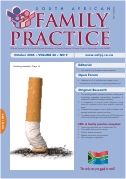A Qualitative Study Of The Reasons Why Pulmonary Tuberculosis Patients, At Clinics In The Wellington Area, Stop Their Treatment
Keywords:
Tuberculosis, treatment, compliance, qualitative research, south africa
Abstract
Background The objective of the study was to explore and describe some of the reasons why TB patients in Wellington drop out of the treatment program in order to recommend solutions and to improve understanding of fears and feelings of patients. Design A descriptive qualitative study. Setting Drakenstein Municipal District, Wellington, Western Cape, South Africa. Methods Free attitude interviews were conducted with six non-adherent patients from Van Wyksvlei, a sub economic area. The exploratory question was ‘Which circumstances resulted in your interruption of your treatment?��? Patients’ responses were recorded and transcribed. Analysis was done to identify common themes. Results The major themes were priorities, motivation and support. Priorities imply definite choices the TB patient has to make from the day the diagnosis is made. The patients are poorly equipped with decision making and coping skills. A lack of motivation, resulted from improvement of symptoms on medication, group pressure, poor self-esteem, distance from clinic and lack of continuity of care. The support theme centred on lack of support from both family and community. Conclusions Patients should not carry primary responsibility for their adherence, but be part of a team. If TB treatment is to be optimised, patient cooperation and information need to be addressed, as it is essential to success. Existing services need to be made more accessible and acceptable. Additional effort for community education is needed.
Published
2006-11-30
Section
Original Research
By submitting manuscripts to SAFP, authors of original articles are assigning copyright to the South African Academy of Family Physicians. Copyright of review articles are assigned to the Publisher, Medpharm Publications (Pty) Ltd, unless otherwise specified. Authors may use their own work after publication without written permission, provided they acknowledge the original source. Individuals and academic institutions may freely copy and distribute articles published in SAFP for educational and research purposes without obtaining permission.

